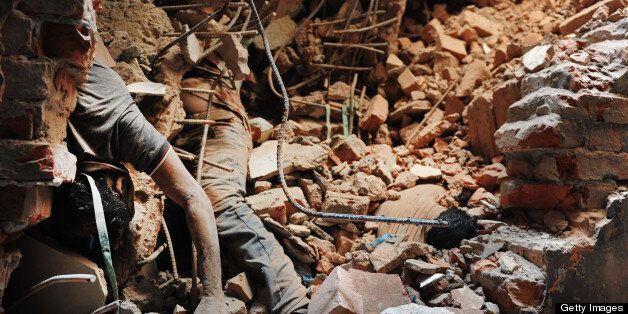
The stench of decomposing bodies is hindering rescue efforts in Bangladesh's garment industry hub of Savar, witnesses say, as untold numbers of dead and dying workers lie buried under the rubble of a collapsed building.
"You cannot stand the stench long," Selim Ahmed, a local journalist, told The Huffington Post from the scene Friday. "It seems several thousand bodies are rotting under the debris."
Hope of finding more survivors is fading fast amid the stumbling rescue effort. At least 304 people had been confirmed dead as of Friday night, and it remains unclear how many more remain buried.
Meanwhile, thousands of garment workers took to the streets in Bangladesh's capital Dhaka and elsewhere in the country Friday to protest the deaths. At least three garment factories were set on fire, several others were vandalized and dozens of vehicles were damaged during the frenzied protests, which began in the morning and went on for several hours.
The victims are thought to be mostly garment workers, because the workers were required to come to work Wednesday, the day of the collapse, despite large cracks that had developed in the building the previous day. The building, called Rana Plaza, housed five garment factories, a bank and commercial shops. Those employed by the bank or by the commercial shops did not turn up for work as the building was already found vulnerable. The building owner, Sohel Rana, who declined to shut down his establishment after it developed cracks, has been on the run since the collapse.
The rescue operation led by the Bangladesh army has fallen far short of expectations, as over 659 families reported missing family members to the police as of Friday night. The rescuers are just a day away from their pre-announced plan to remove the wreckage on Saturday.
On Friday morning, locals and family members of the missing workers clashed with police and army soldiers, protesting the slow pace of the rescue work, which the protesters called "unstrategic," "cumbersome" and "suffering from serious coordination problems."
Ahmed, the journalist, says he witnessed police firing at least a dozen rubber bullets and lobbing the same number of teargas canisters to disperse the protest that broke out around 10 a.m. near the collapsed building. Members of the army also charged in with batons to calm the situation, he said. Protesters pelted the police and members of the army with stones and brickbats, and the 15-minute fight left at least 35 injured, according to Ahmed.
"Relatives of the victims could not take it anymore to see through the wreckage the dead body of their loved ones," Ahmed said.
Since the collapse, responders have repeatedly said that they are trying to rescue those who are still alive first and then go for the dead, unless bodies come along their path. The rescuers claim to have pulled out 2,300 of the 3,000 garment workers trapped under the rubble. But immediately after the collapse, Bangladeshi media had reported the number inside the building at the time of the collapse to be over 5,000.
Civilians and family members have been contributing heavily to the effort, filling the void. "In fact, the government rescuers are contributing insignificantly to the rescue compared to the general people," said Ahmed, who like many others thinks the public is conducting more of the rescue effort than the authorities. "More lives would have been saved had the work been well-coordinated."
The large protest Friday comes a day after prime minister Sheikh Hasina blasted those who criticized the rescue work.
But the insufficent rescue operation has angered online activists as well, who have tried to collect money through online appeals for oxygen, dry food, lights and water, both for the workers who are trapped and also for those laboring to rescue them.
In the wake of the protest, the Bangladesh Garment Manufacturers and Exporters Association and Bangladesh Knitwear Manufacturers and Exporters Association have announced that all of their garment units will remain shut on Saturday and Sunday.
Wednesday's disaster is a grim reminder of the dangers faced by impoverished Bangladeshi garment workers, many of whom produce clothing for American consumers. Hundreds die in fires and other disasters each year. Many of the factories they toil in are in disrepair, receiving weak oversight from government officials and poor enforcement of labor laws.
The Tazreen factory that burned in Bangladesh last year, taking more than 110 lives, had been producing clothes for Walmart, among other retailers. Emergency exits had been blocked and windows covered with steel bars, according to reports. Managers told employees who'd heard rumors of a fire on another floor to go back to work. Many of the survivors jumped from the burning building.